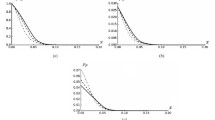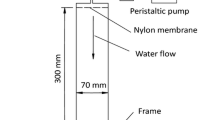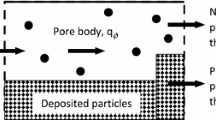Abstract
Flow of suspensions in porous media with particle capture and detachment under alternate flow rates is discussed. The mathematical model contains the maximum retention concentration function of flow velocity that governs the particle release and is used instead of equation for particle detachment kinetics from the classical filtration model. An analytical model for suspension injection with alternate rates was derived, and a coreflood by suspension with alternate rates was carried out. The modelling and laboratory data are in a good agreement, which validates the modified particle detachment model with the maximum retention function.
Similar content being viewed by others
Abbreviations
- c :
-
Suspended particle concentration, L−3
- C :
-
Dimensionless suspended particle concentration
- D :
-
Erosion front velocity, LT−1
- F :
-
Force, MLT−2
- J :
-
Impedance (normalized pressure drop on the core)
- k :
-
Absolute permeability, L2
- L :
-
Core (reservoir) length, L
- m :
-
Growth coefficient of the normalized pressure drop
- p :
-
Pressure, MT−2L−1
- P :
-
Dimensionless pressure
- PVI:
-
Pore volume injected (dimensionless unit for time t D)
- q :
-
Flow rate via core
- r s :
-
Radius of a particle, L
- S :
-
Dimensionless retained particle concentration
- t :
-
Time, T
- U :
-
Darcy’s velocity in porous media, LT−1
- v :
-
Volume of a single particle
- x :
-
Coordinate, L
- β :
-
Formation damage coefficient
- Δ:
-
Difference between two values (pressure, retained concentration)
- \({\varepsilon}\) :
-
Erosion number (ratio between the drag and normal forces)
- χ :
-
Dimensional filtration coefficient, 1/L
- λ:
-
Dimensionless filtration coefficient
- μ :
-
Dynamic viscosity, ML−1T−1
- σ :
-
Concentration of retained particles, L−3
- \({\phi}\) :
-
Porosity
- ψ :
-
Surface potential, mV
- cr:
-
Critical (for retained concentration and co-ordinate of erosion front)
- D:
-
Dimensionless (for linear co-ordinate and time)
- i:
-
Initial condition (for suspended and retained concentrations)
- n:
-
Normal (for force)
- s:
-
Straining (for retained concentration and formation damage coefficient)
- 0:
-
Initial value (for permeability)
- 0:
-
inlet value (for suspended concentration)
References
Ahfir N.D., Benamar A., Alem A., Wang H.Q.: Influence of internal structure and medium length on transport and deposition of suspended particles: a laboratory study. J. Transp. Porous Media 76, 289–307 (2009)
Amix R., Bass A., Whiting A.: Applied Reservoir Engineering. McGraw Hill Book Co, New York (1964)
Bailey L., Boek E.S., Jacques S.D.M., Boassen T., Selle O.M., Argillier J.F., Longeron D.G.: Particulate invasion from drilling fluid. J. Soc. Pet. Eng. 5(4), 412–419 (2000)
Bedrikovetsky P.G.: Upscaling of stochastic micro model for suspension transport in porous media. J. Transp. Porous Media 75(3), 335–369 (2008)
Bedrikovetsky P.G., Marchesin D., Checaira F., Serra A.L., Resende E.: Characterization of deep bed filtration system from laboratory pressure drop measurements. J. Pet. Sci. Eng. 64(3), 167–177 (2001)
Bedrikovetsky P., Siqueira F.D., Furtado C., de Souza A.L.S.: Modified particle detachment model for colloidal transport in porous media. J. Transp. Porous Media 86, 353–383 (2010)
Bergendahl J., Grasso D.: Prediction of colloid detachment in model porous media: hydrodynamics. J. Chem. Eng. Sci. 55, 1523–1532 (2000)
Bradford S.A., Simunek J., Bettahar M., van Genuchten M.Th., Yates S.R.: Modeling colloid attachment, straining, and exclusion in saturated porous media. J. Environ. Sci. Technol. 37, 2242–2250 (2003)
Bradford S.A., Torkzaban S.: Colloid transport and retention in unsaturated porous media: a review of interface-, collector-, and pore-scale processes and models. Vadose Zone J. 7(2), 667–681 (2008)
Bradford S., Kim H., Haznedaroglu B., Torkzaban S., Walker S.: Coupled factors influencing concentration-dependent colloid transport and retention in saturated porous media. J. Environ. Sci. Technol. 43, 6996–7002 (2009)
Chauveteau, G., Nabzar, L., Coste, J-P.: Physics and modelling of permeability damage induced by particle deposition. SPE paper 39463 presented at the SPE International Symposium on Formation Damage Control in Lafayette, Louisiana 18–19 Feb (1998)
Chupin O., Saiyouri N., Hicher P.Y.: The effects of filtration on the injection of cement-based grouts in sand columns. J. Transp. Porous Media 72, 227–240 (2008)
Civan F.: Reservoir Formation Damage (Fundamentals, Modeling, Assessment, and Mitigation), 2nd ed. Gulf Professional Publishing, Burlington (2007)
Civan F.: Non-isothermal permeability impairment by fines migration and deposition in porous media including dispersive transport. J. Transp. Porous Media 85(1), 233–258 (2010)
Cortis A., Harter T., Hou L.L., Atwill E.R., Packman A.I., Green P.G.: Transport of Cryptosporidium parvum in porous media: long-term elution experiments and continuous time random walk filtration modeling. J. Water Resour. Res. 42(12), W12S13 (2006)
Freitas A.M., Sharma M.M.: Detachment of particles from surfaces: an AFM study. J. Colloid Interface Sci. 233, 73–82 (2001)
Gitis V., Rubinstein I., Livshits M., Ziskind G.: Deep-bed filtration model with multistage deposition kinetics. Chem. Eng. J. 163, 78–85 (2010)
Gravelle, A., Peysson, Y., Tabary, R., Egerman, P.: Experimental investigation and modelling of colloidal release in porous media. J. Transp. Porous Media. (2011). doi:10.1007/s11242-011-9748-3
Guedes R.G., Al-Abduwani F., Bedrikovetsky P., Currie P.: Injectivity decline under multiple particle capture mechanisms. J. Soc. Pet. Eng. SPEJ 14, 477–487 (2009)
Herzig J.P., Leclerc D.M., Le Goff P.: Flow of suspensions through porous media—application to deep filtration. J. Ind. Eng. Chem. 65(5), 8–35 (1970)
Hunter R.J.: Foundations of Colloid Science. Oxford University Press, Oxford, NY (2001)
Ilina T., Panfilov M., Buès M., Panfilova I.: A pseudo two-phase model for colloid facilitated transport in porous media. J. Transp. Porous Media 71(3), 311–329 (2008)
Ju B., Fan T., Wang X., Qiu X.: A new simulation framework for predicting the onset and effects of fines mobilization. J. Transp. Porous Media 68(2), 265–283 (2007)
Khilar K., Fogler S.: Migration of Fines in Porous Media. Kluwer Academic Publishers, Dordrecht/ London/Boston (1998)
Kocaefe D., Bui T.R., Waite P.: 2D transient filtration model for aluminium. J. Appl. Math. Model. 33, 4013–4030 (2009)
Landau L.D., Lifshitz E.M.: Fluid Mechanics (Course on Theoretical Physics, vol. 6), 2nd edn. Pergamon Press, Oxford (1987)
Lefevre D., Comas-Cardona S., Binetruy C., Krawczak P.: Modelling the flow of particle-filled resin through a fibrous perform in liquid composite moulding technologies. J. Compos. A 38, 2154–2163 (2007)
Lever A., Dawe R.A.: Water sensitivity and migration of fines in the Hopeman sandstone. J. Pet. Geol. 7(1), 97–108 (1984)
Li X., Lin C.L., Miller J.D., Johnson W.P.: Role of grain-to-grain contacts on profiles of retained colloids in porous media in the presence of an energy barrier to deposition. J. Environ. Sci. Technol. 40(12), 3769–3774 (2006)
Lin H.-K., Prydko L.P., Walker S., Zandi R.: Attachment and detachment rate distributions in deep-bed filtration. Phys. Rev. E 79(4), 046321 (2009)
Massoudieh A., Ginn T.R.: Colloid-facilitated contaminant transport in unsaturated porous media, Chap. 8. In: Hanrahan, G. (eds) Modelling of Pollutants in Complex Environmental Systems, vol. VI, ILM Publications, Hertfordshire, Glensdale (2010)
Mays D., Hunt J.: Hydrodynamic aspects of particle clogging in porous media. J. Environ. Sci. Technol. 39(2), 577–584 (2005)
Miranda, R.M., Underdown, D.R.: Laboratory measurement of critical rate: a novel approach for quantifying fines migration problems. SPE paper 25432 presented at the Production Operations Symposium held in Oklahoma City, OK, Mar 21–23 (1993)
Nabzar, L., Chauveteau, G., Roque, C.: A new model for formation damage by particle retention. SPE paper 31119 presented at the SPE International Symposium on Formation Damage Control in Lafayette, Louisiana, 14–15 Feb (1996)
Noubactep C., Care S.: Dimensioning metallic iron beds for efficient contaminant removal. Chem. Eng. J. 163, 454–460 (2010)
Ochi J., Vernoux J.-F.: Permeability decrease in sandstone reservoirs by fluid injection. Hydrodynamic and chemical effects. J. Hydrol. 208, 237–248 (1998)
Panfilov M., Stepanyants Y., Panfilova I.: Mechanisms of particle transport acceleration in porous media. J. Transp. Porous Media 74(1), 49–71 (2008)
Pang S., Sharma M.M.: A model for predicting injectivity decline in water-injection wells. (SPE paper 28489). J. SPEFE 12(3), 194–201 (1997)
Payatakes A.C., Tien C., Turian R.M.: A new model for granular porous media. I. Model formulation. AIChE J. 19(1), 58–76 (1973)
Payatakes A.S., Rajagopalan R., Tien C.: Application of porous medium models to the study of deep bed filtration. Can. J. Chem. Eng. 52(6), 722–731 (1974)
Rahman, S.S., Arshad, A., Chen, H.: Prediction of critical condition for fines migration in petroleum reservoirs. SPE paper 28760 presented at the SPE Asia Pacific Oil and Gas Conference, Melbourne, Australia, 7–10 Nov (1994)
Richards T., Neretnieks I.: Filtering of clay colloids in bentonite detritus material. J. Chem. Eng. Technol. 33(8), 1303–1310 (2010)
Rousseau D., Hadi L., Nabzar L.: Injectivity decline from produced water re-injection : new insight on in-depth particle-deposition mechanisms. SPE Prod. Oper. 23(4), 525–531 (2008)
Schijven J.F., Hassanizadeh S.M.: Removal of viruses by soil passage: overview of modelling processes, and parameters. Crit. Rev. Environ. Sci. Technol. 30(1), 49–127 (2000)
Shapiro A.A.: Elliptic equation for random walks. Application to transport in microporous media. Phys. A Stat. Mech. Appl. 375(1), 81–96 (2007)
Sharma M.M., Yortsos Y.C.: Transport of particulate suspensions in porous media: model formulation. AIChE J. 33(13), 1636–1643 (1987)
Sharma M.M., Yortsos Y.C.: A network model for deep bed filtration processes. AIChE J. 33(13), 1644–1653 (1987)
Sharma M.M., Yortsos Y.C.: Fines migration in porous media. AIChE J. 33(13), 1654–1662 (1987)
Torkzaban S., Kim H., Simunek J., Bradford S.: Hysteresis of colloid retention and release in saturated porous media during transients in solution chemistry. J. Environ. Sci. Technol. 44, 1662–1669 (2010)
Tufenkji N.: Colloid and microbe migration in granular experiments: a discussion of modelling methods, chap. 5. In: Frimmel, F.H., Kammer, F., Flemming, F-C. (eds) Colloidal Transport in Porous Media, pp. 119–142. Springer-Verlag, Berlin (2007)
Tufenkji N., Elimelech M.: Correlation equation for predicting single-collector efficiency in physicochemical filtration in saturated porous media. J. Environ. Sci. Technol. 38, 529–536 (2004)
Wong R.C.K., Mettananda D.C.A.: Permeability reduction in Qishn sandstone specimens due to particle suspension injection. J. Transp. Porous Media 81, 105–122 (2010)
Yuan H., Shapiro A.: Modeling non-Fickian transport and hyperexponential deposition for deep bed filtration. Chem. Eng. J. 162(3), 974–988 (2010)
Yuan H., Shapiro A.: A mathematical model for non-monotonic deposition profiles in deep bed filtration systems. Chem. Eng. J. 166, 105–115 (2011)
Zhou J., Zheng X., Flury M., Lin G.: Permeability changes during remediation of an aquifer affected by sea-water intrusion: a laboratory column study. J. Hydrol. 376, 557–566 (2009)
Author information
Authors and Affiliations
Corresponding author
Additional information
Dedication: The article is dedicated to memory of Vladimir Markovich Entov.
Rights and permissions
About this article
Cite this article
Bedrikovetsky, P., Zeinijahromi, A., Siqueira, F.D. et al. Particle Detachment Under Velocity Alternation During Suspension Transport in Porous Media. Transp Porous Med 91, 173–197 (2012). https://doi.org/10.1007/s11242-011-9839-1
Received:
Accepted:
Published:
Issue Date:
DOI: https://doi.org/10.1007/s11242-011-9839-1




